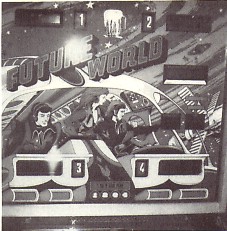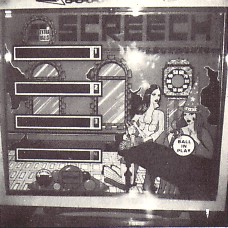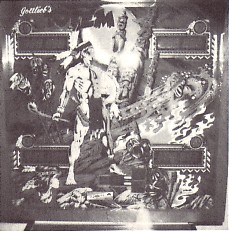
Playmeter Magazine:
Critics Corner
by Roger C. Sharpe



|
Playmeter Magazine:Critics Cornerby Roger C. Sharpe |
  |
A Few Favorites From AfarThe summer season is winding down, and for many the woes of the gasoline shortage have helped redefine peak times for certain locations. June to September was always considered a rather soft time for pinball machines; most companies even going on vacation, shutting down in order to get the energy back for the big fall push.This year, however, although attitudes may not have changed, the fact remains that many of the inner city locations have enjoyed a rebirth thanks to the gas shortage and the less mobile nature of most people. No one is going too far away from home, depending on what area of the country they are living in and the accessibility of gasoline. What this portends for the future, when fuel shortages become a more consistent occurrence, remains to be seen, but the summer trend toward growth outside the city may now have to be re-evaluated to allow people the chance to get to the games, let alone to play them. What was normally the case was that this time of year was an opportunity for all manufacturers to move some filler equipment so you were sure to come across some unknown company and one of their products-- usually a foreign manufacturer (though not this year as the majors have firmed up their market shares). If anything, this is the summer which will be remembered for the incredible success of Flash and the re- establishment of Williams in the marketplace. Other standout achievements will be the acceptance, if not need, for the wide-body pinball machine, with this year supplying the chance for all of the majors, except Stern (as of this writing), to establish at least one wide-body for their arsenals. Beyond this is the awareness that this year less foreign games found a home on these shores. But since foreign equipment is still a viable alternative, the pieces can't and won't be ignored in this column as time goes on. In fact, due to the theme of this month's issue, the majority of games reviewed will be from across the Atlantic. Zaccaria's FUTURE WORLD
Not to be confused with Strange, Lost, New, or Third, or any of the other World games (even World Cup), comes this four-player, solid state effort from a fairly fertile Italian manufacturer. PLAYFIELD: The action starts out with a two post and saucer kick-out hole at the top of the field. Move down and there are three thumper bumpers flanked on the right side by three targets and the left side by a long kicking rubber that is part of a left side drop target bank featuring five obvious drop targets and a sixth target netted behind the center drop target. On the right side across from this is a short rollover button lane that tops an area that also has a saucer kick-out hole just below the access point. The left side is a long six rollover button arc for shots back to the top, or those that roll down this way. The bottom is a Zaccaria variation on the standard Gottlieb (Italian bottom of wire lanes and flippers). This company opens up the wire form and adds a post for some nudging possibilities on out-lane balls. ANALYSIS: The play on Future World is unfortunately not powerful enough off the flippers, and is also unbalanced, with too much emphasis on the left side and not enough on the right side. But the biggest problem this manufacturer has faced on most of its recent efforts lies in the power off the flippers. Compared to the new domestic models, it is like night-and-day, and only detracts from whatever merit the games do have. More unfortunately, here, most of the shots are long away from the flippers. There is some nice play possible to the drop targets or even the right side kick-out hole, but the top becomes a dead issue, and that set of posts and the saucer kick-out hole loom useless.
PLAY: With 5X a possibility, the scoring potential on Future World is adequate by today's standards. For three-ball free play, go with a 150,000 start, followed by 300,000 points and 450,000. Lower this by about 30,000 to 50,000 points for each limit on extra ball play. On five-ball, you can increase the levels by this same amount, again depending upon the caliber of play in the particular location.
Zaccaria's QUEEN'S CASTLE Remember scoring drums and black numbers on white background? Well, obviously Zaccaria does, because they feature the dying breed with this new electro-mechanical effort (and a single-player to boot).
Remember scoring drums and black numbers on white background? Well, obviously Zaccaria does, because they feature the dying breed with this new electro-mechanical effort (and a single-player to boot).
PLAYFIELD: Once again, we have another saucer kick-out hole to start the action, this time better flanked and closed in, similar to such Williams' games as Triple Strike. Move down a bit to two thumper bumpers and a roundabout on the right top. At the top left is a short access, back to the top, with a valued rollover button. The center is taken up with a spinner and post set-up that is fairly head-on and the sides offer five targets each that is almost hidden from view when playing. Down a bit and a first set of flippers is in evidence on either side. Move to the bottom and it's the Zaccaria variation again with flippers and wire lanes along with the opening and post possibilities.
GRAPHICS: Queen's Castle is a nice looking game, not remarkable by any stretch of the imagination, but a good blending of subtle tones and a pretty- as-a-peacock playfield (with the latter a dominant part of the board's artwork). It's a return to basics, and for this reviewer, achieves the desired effect much better than Future World. PLAY: The scoring is going to be grand on any scale, and for five-ball play, which is a must here, try the following limits for extra ball areas: 500,000 points to start, followed by 800,000 and 1,200,000 points. On free play you may want to up this by about 100,000 points to each limit depending upon location and players.
Inder's SCREECH
This Spanish company keeps churning them out, most with a Gottlieb influence, although this four-player effort does come through with a bit of a different personality. PLAYFIELD: Four lanes at the top begin with the action and lead down to a three thumper bumper middle. There's an access back to the top at the left side and two short kick-back kickers at both the right and left sides. Move down and there are two drop target banks on both sides with four color-keyed drop targets and a fifth behind the drop targets. Also behind the lower target (the red one) are two captive balls, with Inder doing much to economize space. Two more targets on either side finish off the board before one gets down to a double lane set up to the flippers. ANALYSIS: Inder, as many Spanish manufacturers, offers much more to most playfields than initially meets the eye. The best example of this is its multiple use of a standard drop target bank and the other features it builds into this space. Here, with a fairly symmetrical board, Screech offers some good play, but the death of the game is a weak, wide open center that may mean sporadic play that's far too precise for domestic tastes. This is especially true when you add the increased slope of the playfields from these manufacturers. The flipper power is adequate, but not nearly as good as it should and must be to work on a machine of this type where the shots are relatively far away. But the nice touch is the fuller use of the drop targets, something foreign manufacturers do with abandon.
PLAY: Screech offers some decent scoring potential, but you may want to try some realistic limits on three-ball, free play of about 180,000 to start, followed by 360,000 and 500,000 points. Lower this by about 30,000 to 50,000 points for extra ball play. And on five- ball play go up by about 20,000 to 50,000 points for some reachable limits.
Gottlieb's TOTEM
The newest from Gottlieb features a new and different sound system and some interesting features and play, as well as a motif of a truly native American. PLAYFIELD: Totem is something borrowed and modified from other Gottlieb machines with a top four lane set (A-B-C-D) and a three rollover button right side lane that conjures up memories of Dragon. Two thumper bumpers are at the middle of the field just below the top lanes and are almost enclosed with a right side bull's-eye target, gate to or from the bumper area to the rollover lane (a la Solar Ride). Move down to three sets of two drop targets each that have some openings in between that may mean a drain for some players. The targets are keyed into the top lanes for extra bonus values and multipliers as well as bull's- eye targets behind the drop targets (remember the Inder game?). The left side is a long vari-target shot for bonus multiplier, while on the right side sits a difficult to reach kick-out hole. The bottom is a change of pace, with a kicker and flipper at the right and a double lane set at the left.
Most of the problems stem from the fact that there may be too many possible drains on the game: from the right side rollover lane if the ball bounces a bit at the bottom before getting down to the flippers; from the left side vari-target, which can be adjusted just like Dragon with that lower side rubber post; and lastly, with the ball coming down from the thumper bumpers toward the flippers (or, most often, between the flippers). Because of the necessary precision inherent in the design of the game, Totem may turn off some players. But for the skilled flipperer, the shots are there and so is the play, although it may not be as swift as one would like. It may feel a bit heavy at times. When the ball is hitting off the bumpers or even when the player is making shots from the flippers, it's almost as if the game is just missing, or on a slight delay--but once you adjust to this, the required skill factor is more than enough compensation. GRAPHICS: Totem has artwork which may not tie in with the new sound, but it features a basic, strong figure much like the games during the time of Golden Arrow and, I feel, a much better direction than the token futuristic figures found on Solar Ride and even Pinball Pool. It is good, basic pinball art with nothing fancy or overpowering--a Gottlieb trait which has become a company trademark and tradition, more than anything else. PLAY: On three-ball, extra ball play you may want to be a bit liberal on the game and start with 100,000 points, followed by 200,000 and 350,000 points. On free play you can increase each limit by about 50,000 to 80,000 points. When it comes to five-ball play start with about 220,000 points and follow it with 380,000 and 560,000 depending, of course, upon the players at the location and any feedback you may get. That's it for this time around. Next time, a word on the wide-bodied (as well as "supersize") games and some other good stuff. Also a follow up on Sharpshooter with some hoped-for feedback from any and all of you. And until next month, let me revel in the fact that the Cubs are once again in the penant race (I wear my T-shirt even when they lose, though be it infrequently). And, of course, the White Sox continue to astound those who thought Seattle could overtake them--if only K.C. and Minnesota could continue losing, who knows, they may be a third place team yet. But it's off to Wrigley Field. And so l sign off, as usual...be well and prosper. The Looking Glass
Move to the center of the board and there's an angled set of seven drop targets with the bank spelling out S-H-O-O-T-E-R. The bottom comes next with a variation on a theme. There are two thumper bumpers on the right side and a conventional wire lane and flipper on the left. ANALYSIS: Sharpshooter offers a full memory of features throughout the game tied into bonus multiplier drop targets, and the lanes. Landing in the kick-out hole or hitting down the drop target bank increases bonus multiplier, while spelling out the lanes lights the extra ball feature. Also included is a continually lit 50,000 point lane which has access from the top or from the bottom right flipper on a steer' shot. And to really get to the major point of the design: Sharpshooter is a refinement of two games from the glorious past, its primary influence coming from a Gottlieb golden oldie, Free Fall, or from Sky Jump, depending upon free play or add-a-ball version, and Williams' Satin Doll with its bottom thumper bumpers.
PLAY: Sharpshooter features the first million light indicator of the electronic era, and has the scoring potential for three-ball play to be set for extra ball areas at 180,000 points to start, followed by 360,000 and 600,000 points. For free play you may want to increase these limits by about 50,000 points each, while five-ball play can sustain itself at about 100,000 points more at each level. And one final word has to do with the sound. It is an integrated sound that works into the theme of the game. Hear it and you'll see what I mean. |